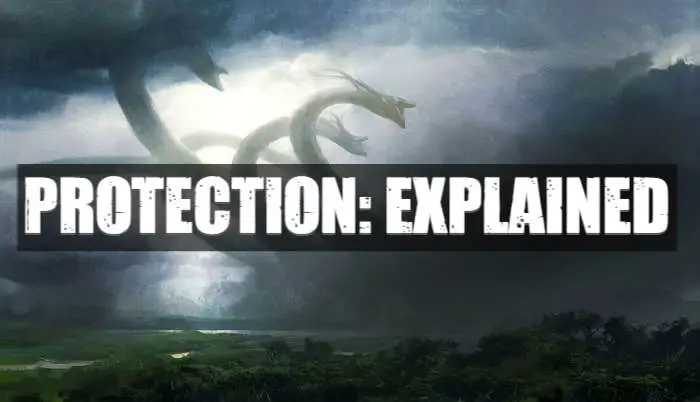Protection is among the oldest abilities in all of MTG. Wizards introduced the ability all the way back in Alpha, and it’s had a big impact on the game of Magic ever since. As well as being one of the oldest mechanics in the game, Protection is also one of the most complicated. In this article, I’ll go over everything you need to know about the Protection ability in MTG.
Protection is a keyword ability found on permanents of all different types. It grants a permanent Protection from a specified quality, most commonly a certain opposing color. For example, white cards often have Protection from black. If a permanent has Protection from a color, card type, or mana value, that permanent cannot be blocked, damaged, targeted, equipped, enchanted, or fortified by any source of the specified color, card type, or mana value.
Protection is one of the most misunderstood mechanics in all of MTG. Its implications run deep and can get pretty confusing. Not to worry. In this article, I’ll break it all down for you. I’ll also give my picks for the best Protection cards in all of MTG today.
Table of Contents
- What Is Protection in MTG?
- Protection Types
- How Does Protection Work?
- Does Protection Stop Trample?
- Does Deathtouch Kill a Creature with Protection?
- Can I Target My Own Creature with Protection?
- Do Board Wipes Work Against Protection?
- Best Protection Cards
- End Step
What Is Protection in MTG?
Protection is a keyword ability introduced all the way back in Alpha. Any type of permanent can have Protection, but Creatures are the most common type. It’s most common for a permanent to have protection from a specific color, usually an enemy color. For example, black permanents are most likely to have Protection from white. This isn’t always the case though.
MTG Protection Types
In addition to single colors, permanents can also have Protection from multiple colors, from all colors, from card types, mana-value and more.
Here’s a list of all the current things the Protection mechanic offers protection from.
| Protection From | Example |
| Individual Color | Black Knight |
| Chosen Color | Prismatic Boon |
| All Colors | Iridescent Angel |
| Multicolored | Enemy of the Guildpact |
| Monocolored | Guardian of the Guildpact |
| Its Colors | Earnest Fellowship |
| Colored Spells | Emrakul, the Aeons Torn |
| Creatures | Beloved Chaplain |
| Legendary Creatures | Tsabo Tavoc |
| Enchantments | Tattoo Ward |
| Instants | Devoted Caretaker |
| Sorceries | Devoted Caretaker |
| Snow | Ronom Hulk |
| Lands | Horizon Drake |
| Players | True-Name Nemesis |
| Mana-Values | Mistmeadow Skulk |
| Planeswalkers | Sparkhunter Masticore |
| Card Name | Runed Halo |
| Everything | Progenitus |
How Does MTG Protection Work?
“A permanent or player with protection can’t be targeted by spells with the stated quality and can’t be targeted by abilities from a source with the stated quality.
A permanent or player with protection can’t be enchanted by Auras that have the stated quality.
A permanent with protection can’t be equipped by Equipment that have the stated quality or fortified by Fortifications that have the stated quality.
Any damage that would be dealt by sources that have the stated quality to a permanent or player with protection is prevented.
Attacking creatures with protection can’t be blocked by creatures that have the stated quality.”
Comprehensive Rules
So if one of your cards has protection from something. How does the protection actually work? What exactly is it protected from? Here’s an easy acronym to help you remember how exactly Protection works.
DEBT. A permanent or player with protection cannot be:
- Damaged by sources with the specified quality.
- Enchanted, equipped, or fortified by permanents with the specified quality.
- Blocked by creatures with the specified quality.
- Targeted by spells with the specified quality, or by abilities from sources of that quality.
Blocking with Protection
Let’s say you have a Black Knight with protection from white. Your opponent attacks you with a white creature, let’s say Thalia, Guardian of Thraben. You block with your Black Knight.
Thalia cannot damage your Black Knight because it’s protected from white and Thalia is white. Your Black Knight, however, can and does damage Thalia. In this situation, Thalia dies and Black Knight survives.
Related: MTG: Blocking – How It Works
In summary, if a creature with Protection blocks a creature that has an attribute it’s protected from, the attack is successfully blocked regardless of the two creatures’ power and toughness. The blocking creature takes no damage, but the attacking creature takes damage as usual.
You do, however, still have to follow all the usual blocking rules. This means you can only block if your creature is naturally able to block the attacking creature. If the attacking creature has flying, for example, and your protected creature doesn’t, you won’t be able to block.
Attacking with Protection
Attacking with a creature with Protection is usually a good idea (assuming you don’t need it to block the following turn). Your opponent won’t be able to block your protected creature with any creatures that have the color/attribute your creature is protected from.
Let’s use the same example as above. You have Black Knight and your opponent has Thalia, Guardian of Thraben. If you attack with Black Knight, your opponent cannot block it with Thalia.
MTG Protection can be wonderful for both attacking and blocking, depending on the situation. Protection basically serves as evasion (like flying), and can be a great way to deal your opponent lots of damage.
One popular combo is to use Giver of Runes to give your strongest creature Protection from your opponent’s blockers. You then swing in for lots of damage, and your opponent is usually helpless to stop you.
On the flip side, using Giver of Runes defensively to protect your best creatures is also a great idea. This versatility makes Protection one of the most powerful mechanics in all of MTG.
Does Protection Stop Trample?
This is where things start to get a bit confusing. Oddly, Protection does not stop an attacking creature from dealing trample damage. I’ll explain why.
To deal trample damage, a trampling creature has to deal lethal damage to its blocker and have excess power remaining. It doesn’t matter if the lethal damage is prevented or not. This is because damage is assigned all at once.
So let’s say your opponent attacks with a 5/5 green creature with trample, and you block with a 1/1 creature with Protection from green. The attacking 5/5 green trampler will assign 1 damage to your 1/1 creature.
That’s enough to be lethal, so it then assigns the remaining 4 damage to you (or a planeswalker you control). Then, when it comes time for damage to actually be dealt, the 1 damage assigned to your protected creature is prevented, but the 4 trample damage assigned to you goes through.
Trample and Double Strike VS Protection
So what happens if a creature with both trample and double strike attacks and you block with a creature with Protection?
Let’s use the same example as above. Your 1/1 creature with Protection from Green blocks an opponent’s attacking 5/5 green creature with trample. This time, however, your opponent’s creature has double strike as well as trample.
Double Strike means that the 5/5 creature will deal damage in the first-combat step and the second. So the 5/5 creature will deal 1 damage to your 1/1 creature and 4 damage to you in the first-combat step. Your creature survives because of its Protection from green. Then, in the second-combat step, it all happens again.
The important thing to remember is this: the 5/5 trample creature has to deal lethal damage to your creature a second time before it can do more trample damage. This means it will deal another 1 damage to your creature, and another 4 damage to you, an exact repeat of the first combat step.
Some players mistakenly believe that the lethal damage dealt in the first combat step remains, and the trampling creature will deal all of its power as trample damage during the second combat phase. Not so.
If an attacking creature with trample and double strike is blocked by a creature with Protection from one of its colors/attributes, the attacking creature needs to deal a lethal amount of combat damage to the blocking creature in both combat steps.
This means that the attacking creature will deal an amount of trample-damage equal to its power minus the blocking creature’s toughness in both the first and second combat phases.
Does Deathtouch Kill a Creature with Protection?
No, deathtouch will not destroy a creature that has Protection from one of the deathtouch creature’s attributes. Deathtouch only works if the creature with deathtouch deals at least one damage. Protection means that no damage can be dealt to the protected creature from a source it’s protected from.
Can I Target My Own Creature with Protection?
No, you cannot target your own creature if the creature has Protection from one or more of the qualities (color, type, etc.) of the spell/permanent you’re trying to use.
This might seem counterintuitive if you’re used to the hexproof ability. Hexproof stops your opponents from targeting your creatures but lets you target them with your own spells all you want. This isn’t the case with Protection though.
If a creature has Protection from red, for example, no player can target it with a red spell. Not even the creature’s control. And this is, of course, true for all other colors and attributes that Protection covers as well.
Do Board Wipes Work Against Protection?
It depends on the specific
Really, the only
Most
Cards like Languish that reduce multiple creatures’ toughness also work against creatures with Protection. Reducing a creature’s toughness doesn’t count as dealing damage, so Protection is powerless to stop the effect.
You can find info on the best
- Best White Board Wipes
- Best Blue Board Wipes
- Best Black Board Wipes
- Best Red Board Wipes
- Best Green Board Wipes
Best MTG Protection Cards
Now that you know all about MTG Protection, I’ll give you my picks for the best cards with Protection in the game today. All of these cards either have Protection from something or have the ability to grant Protection to other stuff. Let’s get right into it.
Sword of Feast and Famine
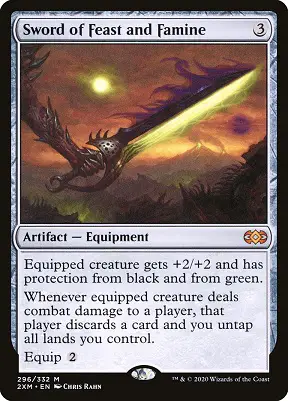
Sword of Feast and Famine gives an equipped creature Protection from both black and green. These two colors are particularly relevant since black is the color of powerful removal and green is the color of powerful creatures.
The sword also gives your creature +2/+2, and lets you untap all of your lands whenever it lands an attack, which will be often, thanks to the Protection. Oh, and it makes your opponent discard a card too.
Sword of Feast and Famine is just loaded with awesome effects making it one of the very best Protection cards in all of MTG.
| Pros | Cons |
| Pays for itself by untapping all of your lands | Useless without a creature, making it a bad top-deck in some situations. |
| Relevant Protection | |
| Hand-disruption |
Progenitus
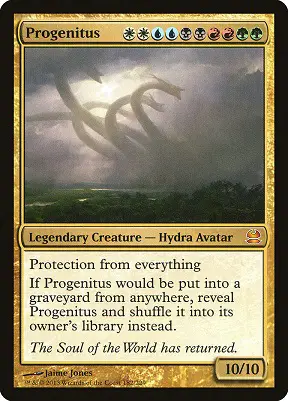
No list of the best MTG Protection cards would be complete without Progenitus. After all, it has Protection from EVERYTHING! That’s one of the most insane lines of text on any Magic card ever.
Progenitus can’t be damaged, equipped, enchanted, blocked, or damaged by anything! I don’t think I need to tell you that this is one of the hardest creatures in the game to deal with. Basically, the only ways to get rid of it are casting a
| Pros | Cons |
| Extremely difficult to remove | Huge mana-cost makes it difficult to cast |
| Impossible to block | |
| High-power |
Kor Firewalker

Kor Firewalker exists for one purpose, and that purpose is to completely and single handedly shut down red-aggro decks.
Not only does it have Protection from red, but it also lets you gain 1 life every time a player casts a red spell. So even if a burn player can get rid of it, they’re going to give you too much extra life in the process.
Kor Firewalker is one of the most powerful sideboard cards of all time, and one of the very best cards to make use of Protection.
| Pros | Cons |
| Completely shuts down Aggro decks | Double white casting cost |
| Good offensively and defensively | Bad against non-red decks |
Emrakul, the Aeons Torn
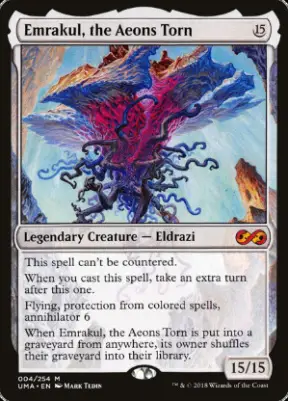
Mana-cost notwithstanding, Emrakul, the Aeons Torn is the most powerful creature with Protection in all of MTG.
It has Protection from all colored spells, making it almost impossible to remove. And it has multiple other effects like granting you an extra turn, being un-counterable, and making your opponent sacrifice 6 permanents whenever it attacks. What more could you possibly ask for?
Very few have ever survived a casting of Emrakul, the Aeons Torn, making it one of the most legendary MTG Protection cards of all time.
| Pros | Cons |
| Wins the game almost immediately if you can cast it or attack with it | Costs 15 mana |
| One of the best creatures to “cheat” into play |
Giver of Runes
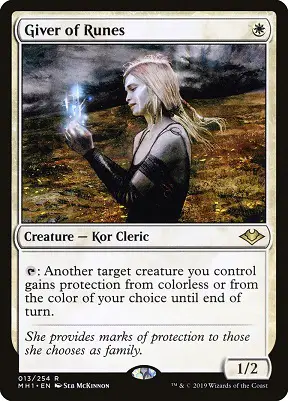
Giver of Runes doesn’t have Protection, but it has the ability to give Protection to any of your other creatures. The best part is that you can choose any color you want to protect your creature from, and you can change it each time you activate the ability.
Giver of Runes costs a measly one mana to cast, and you only have to tap it to activate the ability. Giver is an extremely cost-effective and powerful option for protecting your important creatures from removal, or making them unblockable and pushing through for devastating attacks.
In my opinion, there’s only one Protection card in all of MTG better than Giver of Runes.
| Pros | Cons |
| Only costs one mana | Easy to remove |
| Lets you choose the Protection color every time you activate it | |
| Great offensively and defensively |
Mother of Runes
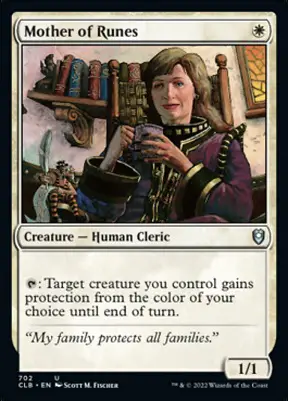
The only Protection card more powerful than Giver of Runes, is the original rune-lady, Mother of Runes, aka mom.
Mother or Runes does everything Giver does, except she can target herself! This takes the card to an entirely new level. For just one mana, you can protect your entire
Mother of Runes isn’t only the best MTG Protection card in all of MTG, it’s one of the best cards period.
| Pros | Cons |
| Only costs one mana | Only legal in Legacy, Vintage, and Commander |
| Lets you choose the Protection color every time you activate it | |
| Great offensively and defensively | |
| Protects itself |
End Step
Protection is one of the most powerful abilities in the game today. As such, Wizards of the Coast doesn’t print new Protection cards very often. Luckily for us, however, there’s already a plethora of awesome cards that use the mechanic in almost every format.
I hope this article has answered any and all questions you may have about MTG Protection. If not, feel free to drop a comment below and I’ll be happy to respond.
Until next time, I wish you the best of luck with all of your MTG endeavors.
